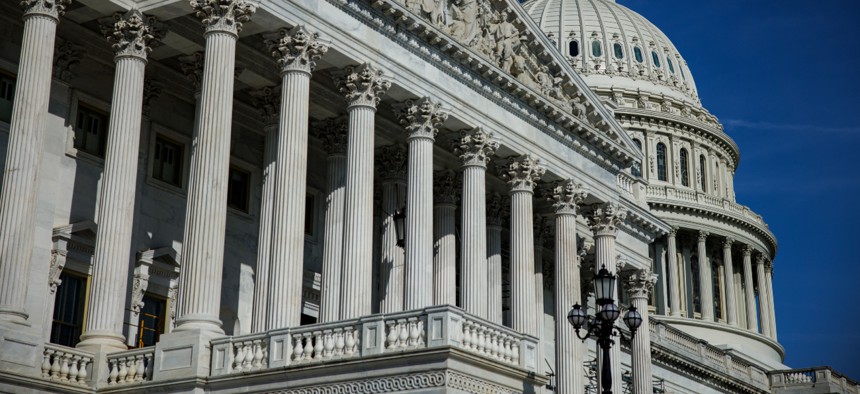House passes 10-week spending bill, averting the threat of a government shutdown for now

The House of Representatives and the U.S. Capitol Dome on Sept. 21, 2022. The continuing resolution passed on Friday will keep the government open past the Sept. 30 expiration of current appropriations. Samuel Corum/Getty Images
The measure now heads to Biden's desk, who is expected to sign it before the midnight deadline.
The House on Friday passed a stopgap measure to keep agencies afloat through Dec. 16, sending to President Biden’s desk a bill to avoid a shutdown Friday evening.
The continuing resolution, which will keep the government open past the Sept. 30 expiration of current appropriations, received bipartisan support after Democrats agreed to drop controversial provisions aimed at speeding up the permitting process for certain energy projects. Biden is expected to quickly sign the measure to avoid any lapse in funding that would force agencies to shutter.
The roughly 10-week spending bill will keep agencies funded at their current levels into the lame duck session of Congress, punting on full-year appropriations until after the midterm elections but creating a new deadline before the new Congress is seated. The measure includes "anomalies" to provide funding increases for certain programs, such as $400 million to increase hiring at the Social Security Administration; $20 million for the Army Corps of Engineers to assist with the water crisis in Jackson, Mississippi; and $1 billion for the Health and Human Services Department's Low Income Home Energy Assistance Program. It also includes more than $12 billion for Ukraine aid, matching the White House’s request, and new funding for disaster relief. It will not provide the requested funds to address monkeypox and COVID-19.
The CR will reauthorize user fees for the Food and Drug Administration. Absent congressional action, the agency's ability to collect the fees would have expired at the end of the month and 3,500 employees would have faced layoffs or furloughs. The agency held off sending official notices to employees, citing expectations that Congress would act.
Sen. Patrick Leahy, D-Vt., who chairs the Senate Appropriations Committee, told reporters Tuesday that getting bipartisan agreement on the CR—absent the permitting reform—was a difficult process that required months of negotiations with his panel’s ranking member, Sen. Richard Shelby, R-Ala.
“We've reached an agreement on virtually every contentious part,” Leahy said. “I didn't get every single thing I want and Shelby didn't get every single thing he wants. But both parties got a lot more than we might have if we hadn't had people negotiate.”
The Senate approved the bill on Thursday in a 72-25 vote, essentially ending the shutdown threat. Before the announcement that the permitting reforms were removed from the CR, there had been great uncertainty over how Congress would keep agencies open come Saturday morning. House Republicans overwhelmingly voted against the bill, but the Democratic majority held together to send the bill to the White House.
Congress now has 10 weeks to come up with full-year appropriations or approve another stopgap measure. Democrats and Republicans remain sharply divided on the top-line funding levels for defense and non-defense agencies. House Republicans have pushed to keep government funding on autopilot through CRs until January, when the 118th Congress is seated and their party could control one or both chambers.
Leahy, meanwhile, called on Congress not to pass any more stopgap measures after the new one expires. The House has approved some of the 12 annual spending bills required each year, but it did so with only Democratic support. The bipartisan agreement required in the Senate, therefore, will be negotiated primarily in that chamber.
"Running on autopilot after December would be irresponsible, and the American people deserve more," Leahy said. "Now Congress must do its job and complete the appropriations process before the end of the year.
Shelby said there were still “a lot of things” to iron out for an agreement on full-year appropriations.
“We're not there yet," Shelby said after Tuesday's vote. "If we get the CR out of the way, I think the focus then will all go on the omnibus."






